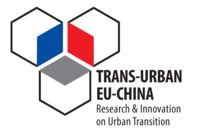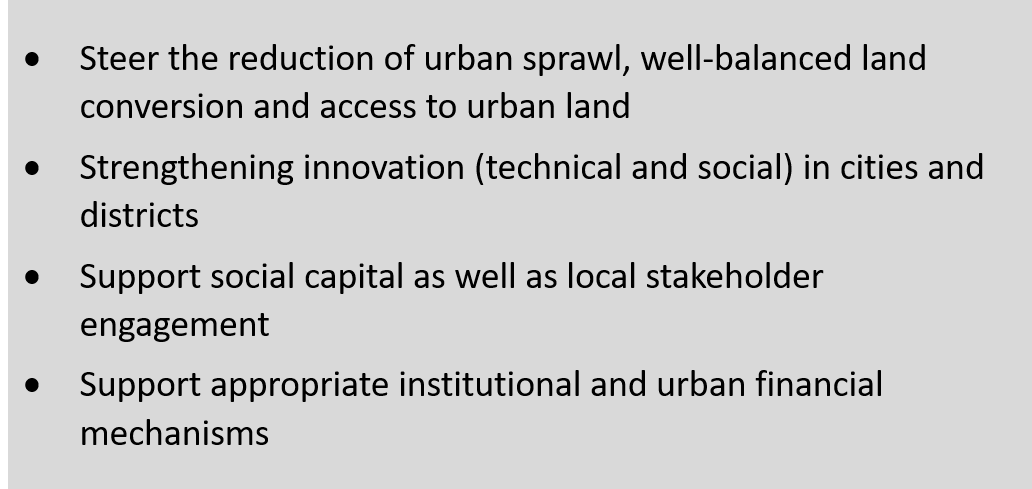
TRANS-URBAN-EU-CHINA
Transition towards urban sustainability through socially integrative cities in the EU and in China
URBAN CONTRACT
1. Purpose(s)
Urban contracts are a prioritized instrument for mobilizing land for building purposes, especially in cities with increasing pressure and tense housing markets in Europe. Negotiations between developers and municipalities are most common in urban development processes.
In the past, they were mostly used for individual steps in the process of building land provision (e.g. development contracts), but today the complete process of building land provision is subject to public contracts between municipalities and private investors/owners (also called urban contracts). The urban contract can be regulated by private law (e.g. transaction of land) and/or public law (replacing legal regulations). Its content focuses on urban development (Weitkamp et al. 2017).
Urban contracts particularly regulate the preparation, implementation or refinancing of the necessary planning and measures. Essential contents can be:
construction or sale deadlines,
promotion of social issues,
the securing of ecological or climate-related guidelines,
permit agreements and several other aspects of urban issues (Deutscher Städte- und Gemeindebund 1999).
The municipality combines the contract with the aim of regulating an overall development that goes beyond its normal legal possibilities to make demands. The behaviour of the municipality is constrained by the need for the investor to generate profits (reasonable levels of burdens and added value).
In this context, the urban contract is a good example of land management supporting socially integrative criteria, as local authorities can transfer these costs to private investors. This leads to a reduction in municipal funding. The contract essentially speeds up the process and creates planning security for all contracting parties. Indeed, the private investor is also interested in the quick availability of the building land so that it can be sold or used.
Key Words: Land development, negotiation, public contract, private contract
2. Relevance and Impact
Fast-growing cities usually have a high economic power, are innovation and creative centres that exert great attraction on the population. Conversely, this also means that these cities are increasingly facing economic, ecological and social challenges. In some cases, the municipalities do not see themselves in a position to meet the challenges on their own. Urban contracts enable the creative and financial involvement of investors in land development to promote socially integrative cities.
The urban contract is a frequently used instrument to financially involve investors in the urban development process. This tool was selected through the analysis of good practices in Europe.
Urban contracts make it possible to negotiate socially integrative aspects with the investor (Box 1). The prerequisite for this, however, is that the municipality has a basis for negotiations e.g. land use planning is needed for development.
Negotiations can be used to develop derelict land, to enable the temporary public use and to improve the living environment in a flexible and fast way (Heck and Will 2007). Thus, land use can be realised as an interim, even if the future (follow-up) use has not yet been determined (Suering & Weitkamp 2020). The instrument is very well suited to indicate short-term improvements. Negative spillover effects that would result from an unused area can be prevented and thus express new dynamics in areas with a particularly negative image.
An agreement could be negotiated to establish a socially integrative interim use of areas that would otherwise remain unused or misused. The owner benefits from common activities on the property while being able to use the area again at a later time. The approval agreement constitutes the legal basis for a temporary (semi-) public operation of a brownfield site or a demolition site without the loss of building rights. It is concluded between the city and the private owner or a civil association. The object of this agreement is the implementation of regulatory measures on the owners land to remedy deficiencies in urban development, to redevelop a neighbourhood and to improve environmental conditions in accordance to urban planning considerations. Different uses are possible: e. g. public green spaces, community gardens, playgrounds or car parks (Rößler 2010; Thiel 2005).
The existing building law on the property is generally not affected by the signing of an approval agreement. No developments are allowed during the term of the approval contract, but the owner can terminate the contract at any time. In this case, he/she must reimburse the costs to the city.
In order to encourage landowners to transfer their land for a limited period of time, the city provides an exemption from property tax and the cost of stormwater drainage for the period of temporary use in individual cases (Fieseler 2004, 38). In this way, any maintenance costs that may arise can be compensated.
In general, through urban contracts, it is possible to negotiate with the developer, that further urban developments are also financed from the development benefit. The content of a contract can cover infrastructure issues so that efficient and affordable transportation can be promoted. Also, a portion of affordable housing or a mix of types of living can be arranged. The development of urban expansion or renewal areas within the framework of city contracts can contribute to strengthen the local economy and the labour market as well as to strengthen (technical and social) innovations in cities and districts. They can also support appropriate institutional and urban financial mechanisms. Box 1 summaries the main points of socially integrative cities, which were promoted by urban contracts.
3. Strenghts
Because of its definite character, both contractors (the developer and the municipality) are bound to the regulation of the contract. They have a transparent overview of the costs and time involved.
With the construction obligation, the time realization can be defined. For these reasons, the instrument can help to reduce the amount of time between planning and building.
In markets under high pressure, the instrument offers the chance of providing low-priced living space. The contract offers the possibility to transfer the building right to the investor under the condition that the investor agrees to make a certain percentage (often 30%) of the property realize as subsidized living space for people with low income or jobs for young people. Segregation processes can often be seen in cities with high housing pressure. Skilful negotiation of contracts can counteract this process and instead create a social mix in the neighbourhood. The instrument can also be used to set regulations in the context of climate and natural protection e. g. used materials, energy efficiency or renaturation of sealed surfaces (Hagebölling 2014). If the contractual contents show a causal connection to the project, there is a large scope for negotiation within the legal possibilities of the country.
4. Weaknesses
A developer will only participate negotiations if the municipality can demonstrate a negotiating position (e.g. preparing of formal land-use plans) and he/she continues to have an investment incentive. If the suggested costs do not cover the higher profits, the developer will refrain from the contract. The smaller the profit from development, the smaller the scope for negotiating contracts will be. The necessity of the investment incentive also means that private developers will not be found in difficult situations. Unprofitable costs (e.g. in the revitalisation of brownfield sites) must be compensated by other instruments.
5. Good practice examples
Building land strategy within the context of an urban contract in Berlin, Germany
In Berlin (map) urban contracts are negotiated on the base of a pre-defined strategy and topic. General terms for the contract are already set up in Berlin. Further regulations can be set up in the contract. The general terms will be updated whenever necessary. It defines the following topics:
Inclusion of a quota for rent-related and occupancy-related living space of 30 % of the floor area of living space
- Adaption to the housing promotion regulation
- Adjustment of the planning guidelines for day care
- Adjustment of the cost parameters in new residential construction
- Adjustment of the flat-rate cost estimates for the production of the day care and primary school places
- Adjustment of the manufacturing costs for streets, paths, neighbourhood squares, green areas and playgrounds.
Approximately 10 – 20 contracts are closed in Berlin on a base of the general terms per year.
Urban contract (contrat de vile) in Paris (France)
The urban contract in Paris (map, contrat de vile, 2015-2020) followed an urban contract for social cohesion (Perulli 2016). It is still used in context of social integrity. The agreements on specific aims are signed by ministerial or state partners which define measures to be taken in neighbourhoods. These measures can constitute targeting them for 30% of jobs for young, unqualified job seekers (emplois d’avenir) or 25% of the civil services have to be provided for young people in the area. They are applied in a geographically defined area of Paris in so-called priority neighbourhoods (quartiers prioritaires).
6. Further helpful study material
Further information related to the above mentioned case studies as well as to additional European cases are provided in the following documents:
- Berlin urban contract: https://www.stadtentwicklung.berlin.de/wohnen/wohnungsbau/de/vertraege/ (retrieved 31.07.2020)
- Paris urban contract: https://www.apur.org/en/search?keyword=urban+contract (retrieved 31.07.2020)
7. References
FIESELER, G. (2004). Gestattungsvereinbarung zur befristeten Nutzung von Baulücken. Leipziger Sanierungsratgeber. o. S.
HAGEBÖLLING, C. 2014. Klimaschutz durch städtebauliche Verträge. Klimawandelgerechtes Städtebaurecht vor dem Hintergrund desGebäudeenergiefachrechts, Tectum Verlag Marburg, ISBN: 978-3-8288-3441-5.
HENDRICKS, A.; KALBRO, T.; LLORENTE, M.; VILMIN, T.; WEITKAMP, A. 2017. Public Value Capture of Increasing Property Values – What are “Unearned Increments”? In: Land ownership and land use development – The Integration of Past, Present, and Future in Spatial Planning and Land Management Policies (2017), S. 257–282.
PERULLI, P. 2016. The Urban Contract: Community, Governance and Capitalism, Taylor & Francis Ltd, 1st Edition, ISBN: 978-1472445902.
RÖßLER, S. (2010). Freiräume in schrumpfenden Städten. Chancen und Grenzen der Freiraumplanung im Stadtumbau. IÖR-Schriften, 50, Berlin: Rhombos-Verlag.
SUERING, J., WEITKAMP, A. 2020. Sucess Factors of Building Land Strategies: Differences and Commons of the Approaches in Levine-Schnur, R., Measuring the Effectiveness of Earl Estate Regukation. ISBN 978-3-030-35621-7
THIEL, F. (2005). Flächenkreislaufwirtschaft am Beispiel des Stadtumbaus - Gestaltungsmöglichkeiten und eigentumsrechtliche Hemmnisse. Flächenmanagement und Bodenordnung, 3, 104-109.
TRANS-URBAN-EU-CHINA. 2020. Land management instruments for socially integrative urban expansion and urban renewal in China and Europe. D 3.3 Report.
VAN DER VEEN, M. & KORTHALS ALTES, W. K. 2012. Contracts and Learning in Complex Urban Projects. International Journal of Urban and Regional Research, (5)36, pp. 1053-1075.
WEITKAMP, A.; KLEIN, I. M.; FRIESECKE, F. 2017. Strategies of Developing Building Land in Growing Cities. In: Land ownership and land use development – The Integration of Past, Present, and Future in Spatial Planning and Land Management Policies, European Academy of Land Use and Development (EALD) (2017), S. 327–340.
8. Author(s) of the article
Julia Süring
